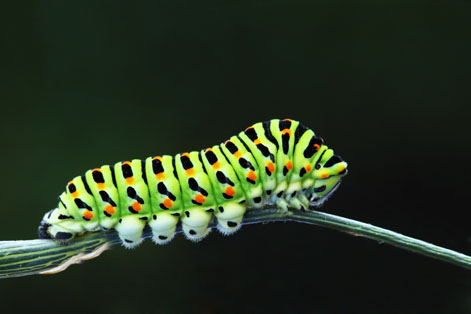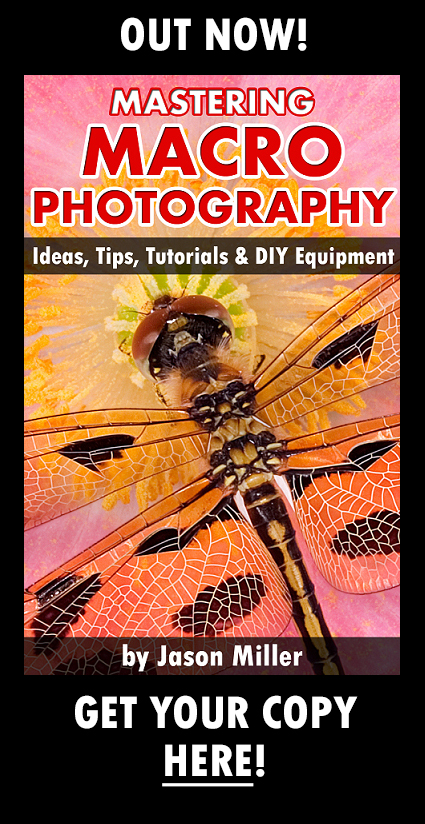Underwater Macro Photography – Interview With Beth Watson
Award winning underwater macro photographer Beth Watson joins us today to give us a glimpse into the underwater macro photography world. We are extremely privileged to have the opportunity to ask Beth some of the toughest questions on underwater macro photography.
We kicked off the interview by asking Beth…
1) What is underwater macro photography? And is there any difference between underwater macro photography and land macro photography?
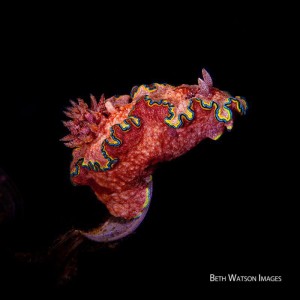
Beth: The classical definition of macro photography is when the image projected on your sensor is actually life size, often referred to as 1:1. Super macro is accomplished by using diopters, teleconvertors and extension tubes, increasing the magnification.
The basic concept of land macro photography and underwater macro photography is the same. However, underwater macro photography presents some unique challenges due to the properties of water and its effect on light. Understanding the properties of water is essential to understanding underwater macro photography.
2) How did your passion for underwater photography start?
Beth: I became a certified diver in 2000 along with my husband and two sons. This is the same year that the St. Louis Football Rams went to Super Bowl 34. For this reason, my husband purchased a Canon G2 for me to take to the memorable game. I didn’t know anything about photography at the time, but I was fascinated by the fact you could capture an image, put it on the computer and print it out.
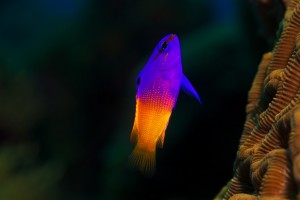
Fairy Tail Basslet – 2006
Soon afterwards, I purchased an Ikelite housing for my Canon G2 and started taking underwater photos on our dive trips. For the next few years underwater photography was a great hobby for me.
It wasn’t until 2006 that I felt like I had captured something special. It was a type of shot that I had never captured before. It had good negative space and the basslet had a catchlight in the eye. Something I was very proud of. This is when I began to see what could be accomplished underwater. I started reading, researching and practicing, trying to improve my skills. This is when my passion began.
Five years later, in 2011, I began entering photography and print competitions. My passion has now been turned into an obsession. That is fine with me, because I truly love what I am doing.
3) What is the typical day for the underwater macro photographer?
Beth: The day usually starts out early. Grab a cup of coffee or tea, then off to the camera room to set up gear. When I am assembling camera gear, I try not to talk to anyone. If you start talking, you can become easily distracted, this is when mistakes are made, and bad things can happen. After the gear is assembled, it is time for a test shot to make sure the strobes are firing and the camera is working properly. A few years ago, I was underwater and realized that I forgot to remove the lens cap, it happens. Now it’s time for breakfast.
 I will usually do two dives in the morning; have lunch, then to one or two dives in the afternoon. Each dive lasts approximately one hour. When I am finished diving for the day it is time to rinse the camera gear with fresh water. The dive resort will have a camera rinse tank available. The camera system goes in the rinse tank, all buttons and levers are pushed to make sure the salt water is rinsed off. The system is then taken to the camera room where it is dis-assembled, the CF card is removed and all batteries are charged.
I will usually do two dives in the morning; have lunch, then to one or two dives in the afternoon. Each dive lasts approximately one hour. When I am finished diving for the day it is time to rinse the camera gear with fresh water. The dive resort will have a camera rinse tank available. The camera system goes in the rinse tank, all buttons and levers are pushed to make sure the salt water is rinsed off. The system is then taken to the camera room where it is dis-assembled, the CF card is removed and all batteries are charged.
Now it is time to gather with your fellow divers, have a beverage of choice, watch the sunset and reminisce about the day’s events. It is the perfect time to elaborate about that “great” shot you may have gotten. After dinner, it is time to download images from the day, checking things out to see if you captured anything worthwhile. Many times images look great underwater on the camera’s display, but in reality, you will be hitting the delete button. Time for bed, sure hope I get a good night’s sleep, because I will get up and do it all over again.
4) So how does someone get started with underwater photography? Is it difficult for someone to learn?
Beth: It is very easy to get started with underwater photography. All you need is a compact camera and an underwater housing for that camera. All major camera manufactures make underwater housings for many of their cameras. This is the most economical way to begin. When you are ready to upgrade, consider housing manufactures such as Nauticam and Ikelite. There are several other housing manufactures to consider, but I have used these two and have been very pleased with their products and customer service.
It would be beneficial to get some instruction before you take your c amera underwater for the first time. Search the web, you will find great articles, tutorials and videos pertaining to underwater photography. Gain as much information as you can before you start out.
amera underwater for the first time. Search the web, you will find great articles, tutorials and videos pertaining to underwater photography. Gain as much information as you can before you start out.
You can research, learn and read all you want, but then you have to apply it all underwater. Keep it simple when you are starting out. Chances are you will be a relatively new diver. It is more important to become a good diver than a good underwater photographer.
As far as difficulty goes, it depends what you want to get out of underwater photography. If you want to snap a few photos for the scrapbook from a recent vacation, it will be very easy. However, if you are interested in shooting manually and with strobes it will take time, patience and practice.
Just a bit of a warning, if you begin this endeavor, chances are you will soon become addicted to underwater photography. Then you will want to upgrade your equipment. The vicious cycle begins. You have been warned.
5) Do you require any special equipment for underwater macro photography? eg. Any special camera, lenses or flash units?
Beth: It depends on how much money you are willing to invest in your equipment. The airlines are making it increasingly difficult to travel with heavy camera gear because of their weight restrictions.
You have basically four choices when it comes to the camera itself; a point and shoot, compact, mirrorless or DSLR. If you choose to go with a pns, compact or mirrorless, do your homework and find out which ones are best for underwater macro photography. There are compact cameras on the market that are capable of producing stunning macro images. At least one strobe is needed to bring out the colors and contrast of the image. A focus light would be beneficial as well. Adding a diopter will help increase the magnification
6) What equipment do you use? – [FB Fan Question by Matt Nicki Lautemann]
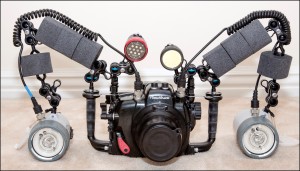
Underwater Macro Photography Equipment – Front
Beth:
- Canon 5D MK3
- Canon 100mm 2.8L macro
- Canon 8-15 4.0L fisheye
- Canon 24mm 1.4L
- Nauticam Housing, Nauticam 180 viewfinder
- Nauticam Macro dome port, Nauticam 8.5in. acrylic dome port
- Dual Ikelite DS 125 strobes
- Ultra Light arms with foam floats
- Light and Motion Sola 1200 LED focus light
- Light and Motion Sola Night Sea (Ultraviolet Black Light) fluorescent imaging
- Subsee +10 diopter
- Tamron 1.4 teleconvertor
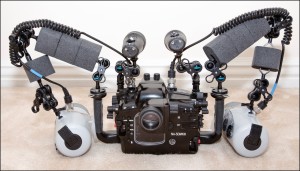
Underwater Macro Photography Equipment – Back
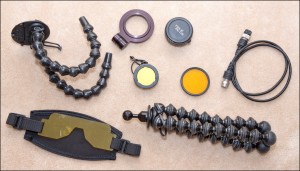
Underwater Macro Photography Equipment – Accessories
7) Does water pressure affect your equipment? – [FB Fan Question by Eric Vettling]
 Beth: Since water is 800 times denser than air, it can create tremendous pressure even at shallow depth. This pressure affects your body, and also the camera that you have in the water-proof housing. If you take an inflatable ball down to 33 feet (one additional atmosphere) it will be half the size, and for every 33 feet more the size of the ball will halve. The same thing is occurring inside your camera housing. The pressure outside the camera is exerting a lot of force on the housing. So your housing has to be very strong, and you have to be sure there are no places where water can seep in and destroy your camera.
Beth: Since water is 800 times denser than air, it can create tremendous pressure even at shallow depth. This pressure affects your body, and also the camera that you have in the water-proof housing. If you take an inflatable ball down to 33 feet (one additional atmosphere) it will be half the size, and for every 33 feet more the size of the ball will halve. The same thing is occurring inside your camera housing. The pressure outside the camera is exerting a lot of force on the housing. So your housing has to be very strong, and you have to be sure there are no places where water can seep in and destroy your camera.
Unfortunately floods happen. Over the years, I have had two housing leaks, with minimal damage and two full-blown floods, ruining two DSLR camera, lens and housing systems. It is not if you ever flood your camera, but when. Fortunately, I have great insurance which covers all my equipment.
8) The enemy for most macro photographers (on land) is wind and lack of light. Does underwater macro photography have anything similar?
Beth: There are two major obstacles for underwater macro photographer to overcome. They are current and backscatter. Imagine keeping your buoyancy under control, paying attention to your gauges, keeping track of your dive buddy, adjusting camera and strobe settings, putting the AF point on your moving or non-moving subject, all while in the midst of a ripping current. It is not the easiest thing to accomplish. There are times when photographing a particular subject is impossible.
It is necessary for macro photographers to use an internal camera flash or strobes. Water has a tendency to suspend small particles. As more of these small particles accumulate, getting in between the viewer and the subject, the visibility of the water deteriorates. Many times these particles show up in underwater photographs effectively ruining a great shot. This is known as backscatter. Backscatter in macro underwater photos becomes much more visible when a flash is used. Proper strobe placement will help to correct this issue.
9) What would be the typical challenges for someone starting out in underwater macro photography? Could it be that the biggest challenge is not related to photography at all? eg. Learning how to dive?
 Beth: Becoming a certified diver would be the first challenge. In my opinion, the single most important factor of learning to shoot underwater macro photography is to have good buoyancy control skills. If you can maintain good buoyancy underwater, taking photographs becomes much easier. It is also very important to acquire this skill because all divers and photographers should respect the underwater environment and take care not to damage the reefs.
Beth: Becoming a certified diver would be the first challenge. In my opinion, the single most important factor of learning to shoot underwater macro photography is to have good buoyancy control skills. If you can maintain good buoyancy underwater, taking photographs becomes much easier. It is also very important to acquire this skill because all divers and photographers should respect the underwater environment and take care not to damage the reefs.
As far as macro photography itself, getting close enough to your subject will most likely the biggest challenge. A rule of thumb: get as close as you can to your subject, then get half as close again. Now, you might be close enough to take the picture.
10) When using a strobe underwater, water must affect the flash and proper exposure in strange ways. What is the rule of thumb for achieving proper exposure? – [FB Fan Question by Eric Vettling]
Beth: Excellent question…Shooting underwater has its challenges. Understanding the properties of water is essential to understanding the basics of underwater photography and lighting.
- The refractive index of water is different than air, which makes judging distances difficult. Objects viewed through your mask can appear 25% larger than they actually are.
- Water absorbs light. Light levels quickly drop as you go deeper and deeper. Reds are absorbed faster than blues.
- Water will take away the contrast and sharpness in photos. This is why you MUST get as close to your subject as possible with or without a strobe.
- Adding a strobe gives you much more control over your image, filling in shadows and bringing back color. Strobe positioning is critical underwater. Avoiding backscatter when using strobes or internal flashes can be challenging. Backscatter is caused by the flash lighting up particles in the water between the lens and the subject.
- Take control of your camera, shoot in manual mode.
- You have the option of shooting your strobe manually or by using TTL. If you are starting out in underwater photography, I would recommend shooting TTL, it is just one less variable to worry about. However, for wide angle shooting and creative macro lighting, using manual strobes settings work best for me.
11) What is your most memorable moment?
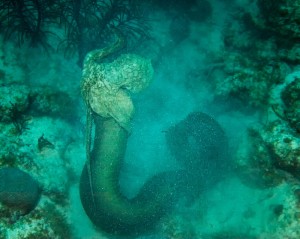
Moray Eel and Octopus – 2006
Beth: I have been fortunate and have had many memorable moments diving. The encounter between the octopus and moray eel was very, very special.
It was an afternoon dive in Belize in 2006 at the dive site Aquarium. Someone in our group pointed out a free swimming moray eel. Not an unusual site, but nice to see. The moray seemed to be on a mission. We watched him gliding so gracefully thru the water, all of a sudden, he make a sharp left and nails an octopus. They were going round and round, tossing and turning, they both were in the fights of their lives. The octopus released his ink on two different occasions. It clouded the water, making it difficult to see who was winning the battle. By this time, we had all formed a circle around the main event. We continued to watch in awe.
All of a sudden, the moray swam away from the octopus as quickly as he attacked. We still didn’t know what happened, or who had won. As the ink dissipated, we knew who had won this battle. There he was, walking gracefully along the ocean floor, all eight arms intact. The yellow tails had gathered, surrounding him, waiting patiently for their next meal. The octopus was headless.
12) What is the toughest ocean plant or animal picture you have taken so far? – [FB Fan Question by Sonja Franklin]
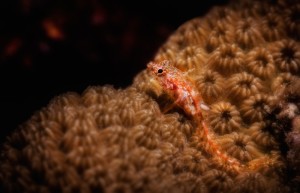
The elusive Blenny
Beth: I was in Bonaire, looking at a coral head, searching for something to photograph. Sometimes I like to find a pleasing background, and then find my subject. I saw something move out of the corner of my eye. I was determined to find out what it was. After searching several minutes I found him. The challenge was on.
This blenny was exceptionally small. It took time, patience and perseverance, to get this shot. I captured two images in 30 minutes. What made this shot so challenging is that he was so tiny and well camouflaged; one AF point on the camera covered the entire animal. The camera had a very difficult time focusing. To top it off, I was using a +10 diopter making the depth of field very shallow, even shooting at F/32. This has been the most difficult shot for me to capture so far.
13) To close off the interview, we have a game that we play on the Seeing In Macro Facebook page called ‘The Dilemma’. It is a hypothetical game where the dilemma is that you only have one shot left on your camera. You are faced with a number of unique subjects to photograph but you can only choose one. Imagine yourself with that dilemma now and tell us which subject (below) you will choose to photograph and why?
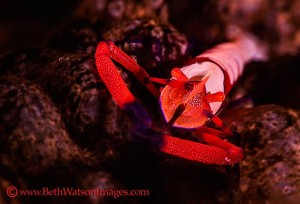
A) Emperor Shrimp
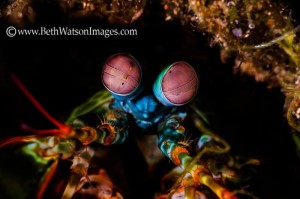
B) Mantis Shrimp
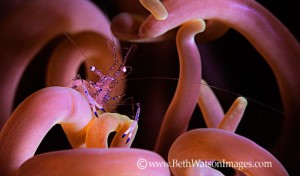
C) Anemone Shrimp
Beth: What a great question! All three are wonderful subjects, it is a difficult decision. Mantis shrimps are probably one of my favorite animals to watch, they scurry around, ducking in and out of crevices, and they always seem to be on a mission. The mantis shrimp arguably has the most complicated visual system of any animal on Earth. The anemone shrimp is a beautiful subject to photograph. They are abundant but difficult to shoot because they are always “dancing” around. The anemones on which they live can make stunning backgrounds. They photograph well if you can get the shot. This leaves the emperor shrimp, a very vibrant and stately looking species, probably the easiest of the three to photograph. However, the emperor shrimp has been very elusive to me. I have seen this shrimp only once and captured just a few images. So at this stage, with one shot left on my camera, I would choose to photograph the emperor shrimp.
—————
We hope that you found the interview with Beth to be an eye opener into the underwater macro photography world. A big thank you to Beth for taking the time out to answer all our questions. We wait in anticipation to see where her next adventure takes her! Please join me in thanking Beth by LIKING and SHARING this interview! Remember to continue to support Beth by following her at http://www.bethwatsonimages.com.
Recommended reading –

